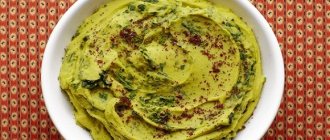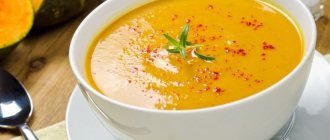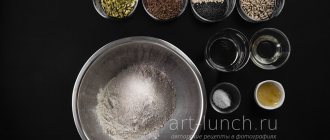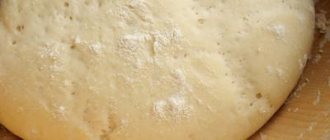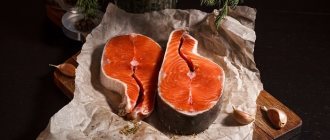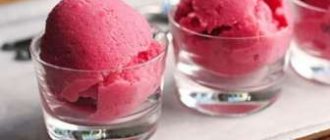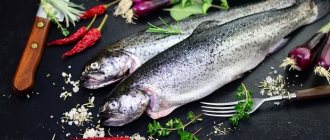Composition and calorie content of salmon
Salmon fillet has a rich composition of nutrients. With minimal heat treatment, the meat fully retains its nutritional value.
100 g of fish contains the following elements:
| Substances that make up fish | Quantitative indicator | Brief description of them |
| Squirrels | 23.21 g | Normalize the activity of all organs and systems. |
| Fats | 14.83 g | They replenish energy reserves and normalize metabolic processes in the body. |
| Cholesterol | 1.13 g | Normalizes hormonal balance and participates in metabolic processes. |
| Iron | 0.82 mg | Participates in the formation of hemoglobin in the blood. |
| Zinc | 0.68 mg | Helps strengthen the immune system. |
| Chromium | 0.56 mg | Normalizes glucose concentration. |
| Molybdenum | 0.35 mg | Takes part in metabolic processes in the body. |
| Potassium | 363.22 mg | Ensures normal functioning of the nervous system. |
| Sulfur | 198.91 mg | Normalizes the activity of nerve cells and the concentration of glucose in the blood. |
| Sodium | 58.98 mg | Regulates the production of enzymes in the digestive tract and water-salt balance. |
| Calcium | 9.53 mg | Normalizes blood composition and nervous system activity. |
| Phosphorus | 209.11 mg | Participates in energy metabolism and ensures the strength of teeth and bones. |
| Magnesium | 29.99 mg | Normalizes the activity of the nervous system. |
| Chlorine | 164.13 mg | Regulates the concentration of glucose in the blood. |
| Iodine | 223.14 mg | Normalizes the activity of the thyroid gland. |
| Cobalt | 1.28 mg | Participates in metabolic processes. |
| Copper | 0.58 mg | Normalizes the activity of the cardiovascular system, participates in metabolic processes. |
| Vitamins | A 0.32 mg | Helps strengthen immunity and vision. |
| RR 9.92 mg | Normalizes metabolic processes in the body. | |
| E 2.53 mg | Regulates blood composition and nervous system activity. | |
| B1 0.16 mg | Participates in metabolic processes and supports the functioning of the nervous system. | |
| B2 0.19 mg | Normalizes light perception. | |
| B5 5.63 mg | Participates in metabolic processes and hormone production. | |
| B 6 5.92 mg | Helps strengthen the immune system and ensure normal blood composition. | |
| B12 22.11 mg | Normalizes metabolism and blood composition. | |
| D 6.02 mg | Ensures the formation and strength of bone tissue. |
There are no carbohydrates in salmon meat, which makes it possible to include fish dishes in the menu for people on a diet and with diabetes.
Composition and calorie content of salmon
The energy value of salmon (in kcal) per 100 g depends on the processing method:
- fresh – 154;
- boiled – 151;
- steamed - 134;
- baked – 187;
- grilled – 198;
- fried – 239;
- smoked – 198;
- lightly salted – 201.
The most healthy and nutritious salmon is steamed, boiled and lightly salted.
Useful properties, effects on the human body
A lot of the positive properties of salmon are associated with the presence of Omega-3 polyunsaturated acids in it. The body does not reproduce such acids on its own; it can accumulate them when receiving food rich in Omega-3.
It is important to regularly eat salmon and other types of fatty fish.
The intake of polyunsaturated acids has a positive effect on the functioning of human systems and organs:

- Prevents the development of heart disease, reduces the likelihood of blood clots, which reduces the risk of strokes, Alzheimer's disease, and heart attacks.
- Makes the walls of blood vessels more elastic.
- Has a beneficial effect on the functioning of the nervous system. Mandatory in the diet of people suffering from depressive disorders, vegetative-vascular dystonia and other diseases of the central nervous system.
- Slows down age-related skin aging, improves the condition of the skin with atopic dermatitis and psoriasis.
- Strengthens the immune system. Eating weekly reduces the occurrence of complications during colds.
The vitamins contained in salmon have the following effects on the human body:
- Retinol is important for normal eye function: it prevents vision loss during prolonged exercise, reduces the feeling of fatigue and pain.
- B vitamins are needed for the functioning of the nervous system, skin, and hematopoiesis.
- Ascorbic acid has antioxidant properties. Protects the body from harmful environmental influences. Activates the immune system during the season of ARVI and colds, preventing morbidity during viral attacks.
- Nicotinic acid promotes the expansion of capillaries and improves blood circulation in the brain.
- Vitamin E is actively involved in the production of collagen, which is necessary for skin renewal. Helps with the functioning of the reproductive system, especially in women. Possessing antioxidant properties, it prevents the occurrence of cancer.
- Vitamin D is an essential vitamin for renewing the human skeletal system. Calcium absorption occurs in the presence of sufficient vitamin D. The body is able to produce cholecalciferol when exposed to direct sunlight, but it is easier to obtain this vitamin from food. Salmon is rich in vitamin D, which is easily absorbed.
Contains a number of minerals:
- Potassium is an essential element for the functioning of the heart muscle, nervous system, and skeletal system.
- Sodium is an important substance for the normal functioning of the body, maintaining the acid-base balance for the normal functioning of the enzyme system.
- Phosphorus is responsible for the condition of human teeth and bones.
- Calcium is a microelement that is responsible for the functioning of the muscular and skeletal systems.
- Magnesium is responsible for the functioning of the heart, nervous system, and muscles. It is often prescribed for high mental and physical stress. It has a vasodilating effect and is involved in the separation of bile.
The chemical composition of salmon includes vitamins and minerals that promote better absorption of each other. This makes the product useful for many groups of the population.
The benefits and harms of lightly salted salmon
Lightly salted salmon, the recipes for which are described later in the article, can have both positive and negative effects on the body when consumed.
| Benefit | Harm |
| Helps eliminate depression and nervous tension by normalizing the activity of the nervous system. | May cause an allergic reaction. |
| Increases the body's resistance to various pathogens. | If you buy expired fish or that have been stored improperly, your body may be poisoned. |
| Strengthens and promotes the development of bone and muscle tissue. | May cause increased blood pressure |
| Normalizes the condition of blood vessels and blood composition. | Deterioration of kidney function due to the presence of salt in the finished product. |
| Improves the activity of the cardiovascular system. | Deterioration of the condition in case of gallstones and urolithiasis (due to salt content). |
| During pregnancy, it promotes the normal formation and development of the fetus. | |
| Normalizes the concentration of sugar, cholesterol and promotes weight loss. | |
| Improves the activity of brain cells, increasing memory and alertness. |
Harm from lightly salted salmon occurs when it is consumed excessively, as heavy metals accumulate in fish fillets.
Calorie content of lightly salted salmon per 100 grams
Calorie content of lightly salted salmon per 100 grams is 195.3 kcal. In a 100-gram serving of this fish:
- 23 g protein;
- 13 g fat;
- 0 g carbohydrates.
Read: Calorie content of fried herring
Lightly salted salmon contains a lot of fatty acids Omega 3, Omega 6, selenium, fluorine, zinc, sodium, calcium, vitamins A, E, C, PP.
Contraindications to the use of the product are exacerbations of diseases of the liver, kidneys, stomach, and intestines. Fish will have to be abandoned if water-salt metabolism is disrupted.
How to choose salmon for salting
Salmon for sale can come either from the sea or artificially grown. Fish caught in the sea has the greatest beneficial qualities. It does not contain chemical additives that were used to accelerate growth and increase weight.
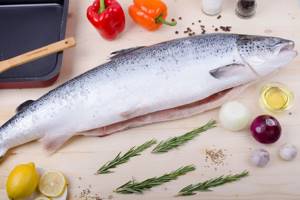
How to choose salmon for salting
When choosing fresh frozen salmon, you should pay attention to the following qualities:
- The fish fillet should only be soft pink in color and elastic (when pressed, the fibers quickly straighten). Darker color is characteristic of “old” fish. And the bright pink tone means the use of dyes to give the meat a more attractive appearance;
- the fillet is loose and pale pink in color, which means the carcass has been defrosted multiple times;
- the scales are slightly damp, but without excess shine, without mucus and stains;
- eyes should be transparent and not sunken;
- gills are pink, the presence of a brown tint is characteristic of stale fish;
- When buying fish without a head or fillet, the edges of the cut should be smooth. The blurriness characterizes the soaking of the fish;
- there should be white streaks in the meat;
- The fish has a characteristic marine smell. A fishy aroma develops during long-term storage.
The shelf life of fresh frozen fish is no more than 14 days. When choosing frozen fish, there should be no ice or snow in the packaging. Their presence means repeated defrosting or improper storage.
How to choose fresh, lightly salted and salted fish
The captured carcasses are cooled. They are sent to processing plants, where they are deep-frozen, salted, smoked, packed in vacuum bags and sent to retail chains.
Often cut into fillets, steaks 2-3 cm thick.
Chilled salmon meat has a soft orange, slightly reddish color.
When pressed, there are no dents left, the flesh is elastic. A fresh carcass has a subtle fishy smell.
Lightly salted or smoked fish is sold by weight or packaged.
Before purchasing, you must check the expiration date of the finished product.
Find out some more useful tips for choosing quality salmon from the video:
How to cut fish for salting. Methods, pros and cons
Lightly salted salmon (recipes often call for already prepared fillets) can be prepared in a variety of ways. Cooking may require only the fillet, or the whole fish. It is important to be able to properly cut fish for the chosen salting.
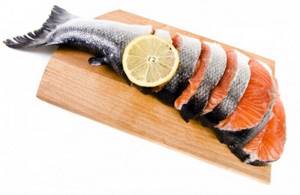
How to cut fish for salting. Methods, pros and cons
Nuances of preparing salmon for salting:
- Rinse the carcass, remove scales, fins and head.
- Remove the insides, rinse the fish with water and dry.
- Next, the fish is cut according to the requirements in the recipe.
Salmon cutting methods:
| Type of salmon cutting | Description of cutting | pros | Minuses |
| Entirely | Salmon can be salted whole, after removing the head, fins and scales. |
|
|
| Pieces | The prepared fish is cut into portions of 3-4 cm, without removing the bones. |
|
|
| Fillet | It is necessary to remove the skin from the cleaned fish in the direction from the head to the tail. It is easily removed due to the layer of fat. The skin must be cut off from the caudal fin. Next, you need to carefully separate the ridge from the fillet, without using a knife. The main bones will remain on the skeleton. If there are small bones in the meat, they can be removed using tweezers. The fillet is ready for salting. |
|
|
| Portioned fillet | Cut the finished fillet into portions |
|
|
Additionally, for salting salmon it is recommended:
- buy fresh or frozen fish;
- use only coarse salt;
- salt only in enamel or glass containers.
The choice of cutting the carcass can be done independently, depending on the further use of the finished meat.
Is it possible during a diet?
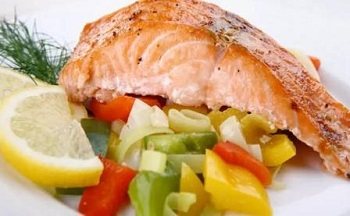
Salmon is prohibited during strict low-calorie diets to achieve rapid weight loss.
However, it is indispensable with proper nutrition for a long-term weight loss effect.
Does not contain carbohydrates. The polyunsaturated acids included in the composition promote the production of leptin, which is involved in metabolism.
70 g of fish per week can replenish protein, vitamins and minerals in conditions of limited nutrient intake during the diet.
It is not advisable to eat lightly salted or smoked fish. Salt retains water in the body, increasing weight.
It is recommended to include it in the diet after short-term heat treatment: boiled, baked or steamed. This way, more nutrients are retained without increasing calorie content.
Classic recipe for lightly salted salmon using the dry method
To salt salmon you will need:
| Main Ingredients | Quantitative indicator in pcs. | Weight in g and ml |
| Salmon carcass | — | 1000 |
| Granulated sugar | — | 20 |
| Sea salt | — | 40 |
| Ground white pepper | — | 5 |
| Fresh sprigs of dill | — | 5 |
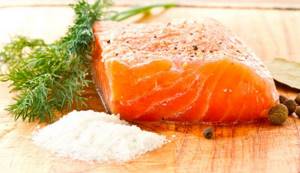
Salting sequence:
- Cut the carcass into pieces. Rinse with water and dry.
- Mix salt with granulated sugar and pepper.
- Chop the dill and add to the salt mixture. To stir thoroughly.
- Place the salmon pieces in a suitable size container. Sprinkle each layer of fish with the salt mixture.
- Cover the contents of the pan with a plate of suitable diameter and press down with pressure. Place in the refrigerator.
The fish is ready to eat in 10-14 hours (depending on the size of the pieces).
Harm to salmon
Contraindications to eating salmon are:
- developed food allergies to fish;
- the period of breastfeeding, since in this case malfunctions in the baby’s gastrointestinal tract are possible and skin rashes may appear;
- liver and kidney diseases (this point is relevant for salted and lightly salted fish).
Research by American doctors has shown that mercury accumulates in salmon meat, which can cause severe food intoxication. When eating fried fish, you gain excess weight and the risk of exacerbation of cholecystitis and pancreatitis increases.
Salmon is a delicious product. The taste qualities of this fish are appreciated by many gourmets. It is good fried, pickled, salted and smoked. This red fish is not only endowed with excellent taste, but it is also healthy.
Recipe for lightly salted salmon pieces in orange juice
To salt salmon you will need:
| Main Ingredients | Quantitative indicator in pcs. | Weight in g and ml |
| Fresh frozen salmon carcass | — | 1000 |
| Cumin seeds | — | 10 |
| Fresh orange | 3 | — |
| Ground coriander | — | 3 |
| Pickling salt, coarse | — | 100 |
| Dill sprigs | — | 5 |
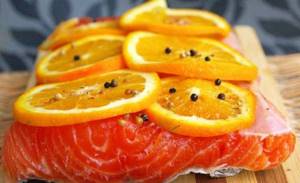
Salting sequence:
- Cut the carcass into pieces. Bones can be removed if desired.
- Mix cumin, ground coriander and chopped dill. Mash the contents with a masher.
- Squeeze juice from oranges. Boil until ½ of the juice evaporates.
- Lay out the salmon in layers. Sprinkle each layer with the prepared spice mixture.
- Sprinkle the last fish layer with salt and pour cold orange juice.
Keep the pan with fish warm for 1 hour and cold for 8 hours. Cover the container with a paper or cloth towel.
Is any salmon good for health?
For quite a long time, environmentalists have been talking on television about the great harm of Norwegian salmon, which was grown artificially. Its quality, compared to natural wild salmon, varies enormously. But what's the matter?
The answer here is quite simple: artificially raised individuals in nurseries are constantly fed pigment additives, antibiotics and growth hormones. All this negatively affects human health. However, quality here largely depends on the human factor, namely the integrity of the supplier.
However, you need to know that almost 95% of all salmon sold on store shelves was grown artificially. But there are several differences that will help you recognize deception:
- Carefully inspect the fins of the fish. In wild ones they are much more developed than in artificial ones;
- The scales of hatchery fish are much duller than those of their oceanic counterparts;
- Wild fish meat should have a pleasant, soft peach color. If you see bright red meat on an individual, then it is almost certainly artificial. Once cooked, it will leave paint marks on the plate;
- Look carefully at the sides of the fish: farmed salmon itself is much thicker than Atlantic salmon.
If you follow these rules and choose a high-quality carcass, it will not cause harm to your health. However, it is better to avoid artificial ones in your diet.
Lightly salted salmon according to a quick recipe with vodka
Lightly salted salmon with the addition of vodka retains its juice and elastic consistency. Instead of vodka in the recipe, you can use cognac, depending on your taste preferences.
To salt salmon you will need:
| Main Ingredients | Quantitative indicator in pcs. | Weight in g and ml |
| Prepared fillet | — | 1000 |
| Vodka | 50 | |
| Pickling salt | 50 | |
| Granulated sugar | 20 | |
| Dill sprigs | 5 |

Salting sequence:
- The fillet can be used whole or divided into portions.
- Mix chopped dill, granulated sugar and salt.
- Coat the fillet thoroughly with the salt mixture. Place in a container.
- Sprinkle the fillets with vodka and cover the pan with cling film.
- Let the salmon soak in the mixture in a warm place for 2-3 hours.
The fish can be consumed immediately. But it’s better to let it sit overnight in the refrigerator.
Recommendations for use
Fresh fish is available to residents of the fishing grounds. More often it goes on sale frozen.
After purchasing frozen fish, the carcass or steaks are left in the refrigerator until completely thawed. This way, beneficial cellular juices will remain in the meat.
Whole fish are thoroughly washed, scaled, the head is cut off, gutted, cut into portions or salted whole or subjected to further culinary processing.
Boiling, steaming, grilling, and baking allow you to quickly cook tender meat , preserving all the benefits without increasing the calorie content of the dish. It is recommended to eat salmon with vegetables for lunch or dinner, no later than 3-4 hours before bedtime.
It is advisable for a healthy person to include fish products in their diet 2 times a week, one of which is a fatty variety. The recommended 70-100 grams of salmon will cover half of the body’s daily requirement in proteins.
It is forbidden to consume more than 250 g per day due to the large amount of protein.
How else to cook salmon tasty and healthy, watch in this video:
Salting fish with lemon
To salt salmon you will need:
| Main Ingredients | Quantitative indicator in pcs. | Weight in g and ml |
| Fresh salmon fillet | — | 1000 |
| Fresh lemon juice | — | 100 |
| Powdered sugar | — | 30 |
| Canning salt | — | 100 |
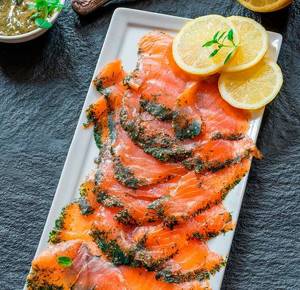
Salting sequence:
- Rinse and dry the fillet
- Mix salt and sugar. Add lemon juice (20 ml) to the mixture.
- Brush the fillet on all sides with the salt mixture and place in the pan.
- Pour the remaining lemon juice over the fish fillets.
- Cover the pan with film and place in the refrigerator for 10-12 hours.
Turn the fillet over and leave to salt for another 12 hours.
Application in medicine
Doctors, having studied the beneficial properties of salmon, concluded that with its regular use in the body [6]:
- metabolism improves;
- blood pressure is normalized;
- the walls of blood vessels are strengthened;
- the risk of developing cardiovascular diseases is reduced;
- the functioning of the liver and other digestive organs improves;
- immunity is significantly increased;
- the activity of the central nervous system is stabilized.
Atlantic salmon fat contains a lot of vitamin D, which has a beneficial effect on the skeletal system, and vitamin A, which regulates metabolism in the mucous membrane of the eyes, thereby increasing visual acuity. In addition, salmon contains sufficient amounts of vitamin B6, which prevents the occurrence of oncology and gynecological pathologies and is responsible for the health of a woman’s body, especially during pregnancy, premenstrual syndrome, and menopause.
Salmon is a rich source of melatonin, a substance responsible for healthy, sound sleep and cell rejuvenation processes in the body. The high phosphorus content has a beneficial effect on the activity of nerve cells, promotes the growth and restoration of bone tissue, and increases physical strength. Therefore, it is recommended to include this type of salmon in children's diets. Atlantic salmon is recommended to replace meat for patients suffering from stomach pathologies, since the protein of this fish is much easier to digest, and besides, it contains all the necessary amino acids.
In modern medicine, drugs such as insulin, pancreatin, compolon and others are made from salmon components.
Lightly salted salmon in brine
To salt salmon you will need:
| Main Ingredients | Quantitative indicator in pcs. | Weight in g and ml |
| Fresh salmon carcass | — | 1000 |
| Drinking water | — | 1000 |
| Coarse salt | — | 100 |
| Lemon juice | — | 30 |
| Dried cloves | 2 | — |
| Black pepper in the form of peas | 2 | — |
| Laurel leaves | 2 | — |
| Allspice in the form of peas | 2 | — |
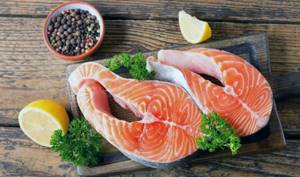
Salting sequence:
- Prepare the brine using all the ingredients except the fish itself.
- Cool the brine and strain.
- The fish can be cut into fillets or pieces, as desired. Pour in the prepared brine. The salmon should be completely covered with it. Cover with a lid.
The fish should sit in the refrigerator for a day.
Salmon in the diet of those who watch their figure
Regarding the form in which this fish is best eaten, there are no changes compared to other meat and seafood products. The most ideal thing is steaming. The calorie content of salmon cooked using a double boiler will reach 178 kcal, but due to the high protein content, even a hundred-gram piece will give you a feeling of fullness for a long time. You can supplement this lunch or dinner - the calorie content of steamed salmon and its overall lightness allow you to consume this dish at any time of the day - with vegetables or rice. Approximately the same picture will be for oven-baked fish, provided there is no fat in the form of butter or mayonnaise. The seafood itself can do without such additives: the meat will not become tough by the time it is ready. But if you wish, you can sprinkle it with lemon juice, which will benefit your slimness. As for how many calories are in salmon cooked in foil, this figure will stop at 102 kcal per hundred grams.
Among those products with which this fish works well in tandem, allowing you not only to avoid gaining excess weight, but also to burn hated fats, there are definitely cucumbers. Considering their satiety characteristics, we can say with confidence that the calorie content of steamed salmon with the addition of fresh finely chopped cucumber will seem ridiculous in comparison with how strongly such a combination repels the feeling of hunger. To enhance the effect, it is recommended to decorate the dish with herbs: parsley, dill or onion.
Salting salmon in beets
To salt salmon you will need:
| Main Ingredients | Quantitative indicator in pcs. | Weight in g and ml |
| Fresh salmon fillet | — | 500 |
| Fresh beets, grated | — | 200 |
| Horseradish root, grated | — | 20 |
| Vodka | — | 30 |
| Lemon zest | — | 15 |
| Dill sprigs | — | 5 |
| Granulated sugar | — | 30 |
| Pickling salt | — | 130 |

Salting sequence:
- Rub the fillet with salt and sprinkle with sugar.
- Mix the horseradish and beets and place the mixture on top of the fillet.
- Sprinkle with chopped dill, lemon zest and vodka on top.
- The fish is wrapped in cling film. And put it in the refrigerator.
The salmon will be ready in 48 hours.
Use in cooking
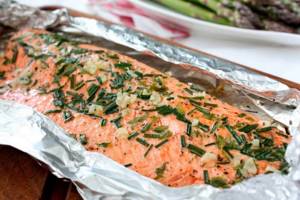
Salmon has a delicate sweetish taste. When fresh, it can be baked, boiled, fried, or used to make soups. You can preserve the most beneficial substances when baking in foil by adding herbs and vegetables.
When smoked and salted, Atlantic salmon is used as a delicacy. This product is suitable for preparing appetizers, salads, various sauces, omelettes, and canapés. Red fish is the main component of sushi and rolls. Pairs well with fresh vegetables, eggs, legumes, olives, cheese, sweet, sweet and sour and spicy sauces.
Salmon in any form is tasty and very healthy. But if it was grown in artificial reservoirs, the nutrient content is reduced by almost half compared to that which grew under natural conditions. That is why, when buying salmon, always be interested in its origin.
You should never fry salmon for a long time, so as not to upset the balance of active components in it. For complete readiness, it is enough to carry out heat treatment for 10-15 minutes, while all useful elements will be completely preserved.
Salting the backbone and belly of salmon for beer at home
Lightly salted salmon (this recipe is the most economical) for beer is popular among men.
To salt salmon you will need:
| Main Ingredients | Quantitative indicator in pcs. | Weight in g and ml |
| Belly or spine of salmon | — | 500 |
| Pickling salt | — | 30 |
| Granulated sugar | — | 15 |
Salting sequence:
- Rinse the abdomen/ridge and dry.
- Mix salt and sugar and sprinkle the mixture over the belly/backbone.
- Place everything in a jar with a lid for the pickling period. And place it in the refrigerator.
Serve after 8 hours.
How is fish good for weight loss?
There are two types of fish that help get rid of fat deposits. These are salmon and tuna. They are rich in protein and contain two fatty acids, which promote the breakdown of subcutaneous fat and “stimulate” metabolism. An excellent option for lunch or dinner is a piece of fish, plus a vegetable side dish. Steamed vegetables are best for this.
Salmon is considered a fatty fish, but due to its low calorie content, it does not harm the figure at all. On the contrary, it stimulates metabolism (due to the amino acids it contains). In addition, due to its high protein content, it satisfies the feeling of hunger for a long time, which makes it possible to avoid snacking on cookies or candy while losing weight.
Of course, you should not abuse it. This fish is rich in protein, so you need to be careful in consuming it daily. Nutritionists advise not to get too carried away and consume no more than 250 grams of it per day.
How to salt whole salmon deliciously?
To salt salmon you will need:
| Main Ingredients | Weight (g or ml) |
| Prepared salmon carcass, fresh | 2000 |
| Coarse salt | 200 |
| Granulated sugar | 100 |
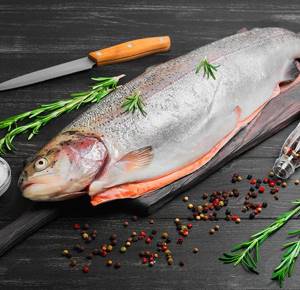
Salting sequence:
- Mix sugar and salt and rub the salmon carcass with this mixture.
- Place the carcass in a bag and put it in the refrigerator.
The salmon will be salted in 12 hours.
How to distinguish from trout?
Anyone who has bought salmon for the table at least once in their life might have noticed that this type of fish is quite expensive. However, there is one more fish, which very often, by its appearance, an inexperienced buyer can mistake for salmon.
Sellers have long noticed that cheaper trout can easily be passed off as salmon. That is why it is better to know the main differences between these two types of fish, so as not to fall for the bait of unscrupulous people.
Differences in size and color
First of all, look at the size of the fish. Typically, a salmon carcass sold in a store will weigh approximately 6-7 kg, while trout only reaches 4. If you put them side by side, the difference will be quite obvious. Very often, female salmon are much larger than males.
In appearance, salmon is a rather beautiful fish with a silvery tint. The color of its flesh varies from pink to bright red. Quite often it depends on the period in which it was caught.
Trout, on the other hand, has quite variegated scales. Near the dorsal fin, it usually smoothly flows from green to black, and its abdomen is white or gray. At the same time, also take a closer look at the sides of the trout: they often have small red or white spots on them.
Body structure
As mentioned earlier, salmon’s body shape is somewhat reminiscent of a torpedo. At the same time, the trout must have a belly, which its brother does not have at all. The next important difference is the fish's head. Since the salmon itself is larger, its head is much larger and slightly elongated. If you look closely at the trout, you will notice that its head is small and round.
If you carefully compare these two types of fish, you will notice that salmon has more developed and longer front fins, and larger scales. In trout it is very small.
In fact, one can argue endlessly about which is better, trout or salmon. The taste of their meat is quite similar, so only true gourmets can catch the nuances, but by their appearance it is quite easy for any buyer to distinguish them.
Nutritional and energy value
Atlantic salmon itself cannot be called an absolutely dietary fish. At the same time, almost any processing, such as frying, salting, smoking and other methods of preparation, only increases its calorie content. If you are watching your diet, it is better to choose boiling or steaming. When using these two methods, the proportion of fat is reduced, and the fish retains significantly more vitamins.
Salmon itself is quite a fatty fish, because the percentage of fat in it is more than 40. The energy value of fresh fish reaches approximately 220 Kcal, and the calorie content is about 155. But at the same time, its nutritional value is simply amazing.
Below is a table that shows the calorie content and nutritional value of salmon prepared using different methods.
As you can see from the table, salmon contains absolutely no carbohydrates, so as a side dish for it it is better to prepare those foods that will help maintain nutritional balance.
Salting salmon fillet
To salt salmon you will need:
| Main Ingredients | Quantitative indicator in pcs. | Weight in g and ml |
| Fresh salmon fillet | — | 1000 |
| Pickling salt | — | 120 |
| Granulated sugar | — | 60 |
| Vegetable oil | — | 50 |
| Dill sprigs | — | 10 |
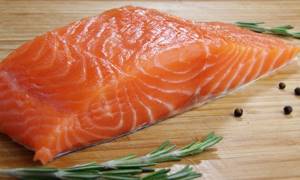
Salting sequence:
- Mix salt with chopped dill and sugar.
- Rub the fillet with the mixture.
- Place the fish in a tight container or bag. Place in the refrigerator.
- In 24 hours, lightly salted salmon will be ready, after 2 days, lightly salted fillet, and after 72 hours, salted salmon.
- Remove the fillet depending on the desired result. Drain the liquid and brush the salmon with oil. Place in a clean container.
Consume fish within 7 days.
Dietary salmon dishes
Salmon is easy to cook; the meat is very tender. We offer you several recipes for delicious and healthy salmon dishes.
Salmon baked in foil. To prepare you will need the following ingredients: 300 g of peeled salmon, 200 g of onions (2 medium onions), 20 g of lemon juice (about 1/3 lemon), 250 g of tomatoes (3 pieces), 70 g of hard cheese, a little vegetable oil , fresh dill and parsley. The calorie content of salmon baked in foil according to this recipe is about 100 kcal per 100 g.
Wash and peel the vegetables, cut the fish into steaks and dry with a towel. Rub the fish with salt and sprinkle with lemon juice. Separate the greens into leaves (branches and stems are not used), cut the onion into rings, tomatoes into circles about 0.5 cm thick, grate the cheese on a coarse grater.
While the oven is heating up, place each steak on a separate square of foil greased with vegetable oil (thin foil can be folded in half) on a layer of onions. Place tomato slices, herbs on top, sprinkle with cheese and lift the edges of the foil to make something similar to a mold. Bake the fish for half an hour in an oven preheated to 180-200 degrees, covering with a layer of foil so that the cheese does not dry out. This layer will need to be removed 5-7 minutes before it is ready.
Grilled salmon is also a very tasty dish that can be combined with rice, fresh and cooked vegetables, potatoes, and pasta. The calorie content of grilled salmon is 230 kcal per 100 g.
It is easy to prepare; when cooking, you can wrap the fish in foil, although you don’t have to do this. Wash the salmon fillet, season with salt and pepper, and lightly sprinkle with lemon. Cut the onion into rings and place in a thin layer, place the salmon on top and cook for about 20 minutes.
Diet salmon soup.
The calorie content of this dish is only 25 kcal per 100 g. It is prepared very simply, and the dish turns out tasty, aromatic and very satisfying. Take 200 g of fresh salmon, 350-400 g of potatoes, 100 g of rice, 1 small carrot, 1 medium onion, 80 g of celery. Wash and dry the ingredients, peel and chop the vegetables for soup. Boil the rice until half cooked in a pan of water. Add potatoes, grated carrots, chopped onions, celery and diced fish to the water. Leave to cook until done (you need to check the readiness by checking the potatoes). Season with salt, pepper, garnish with herbs and serve. If you liked this article, please vote for it:
(4 Votes)
Nov-28-2012
How to salt salmon caviar?
To salt salmon caviar you will need:
| Main Ingredients | Quantitative indicator in pcs. | Weight in g and ml |
| Salmon caviar without film | — | 300 |
| Drinking water | — | 200 |
| Coarse salt | — | 50 |
| Granulated sugar | — | 50 |
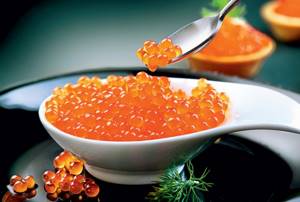
Salting sequence:
- Prepare a brine from salt and sugar. Cool to 70 degrees.
- Place caviar in brine for 15 minutes.
- The brine is drained and the caviar is dried for 2 hours.
Place the caviar in a jar greased with vegetable oil. Keep refrigerated.
Composition of salmon meat

The beneficial properties and nutritional value of red fish are associated with its lifestyle.
The composition of salmon meat includes the following components:
- phosphorus;
- sodium;
- potassium;
- chlorine;
- fluorine.
In addition, the product includes valuable vitamins - B12, A, E. Salmon caviar contains a large amount of vitamin D.
The nutritional value of this product comes from its high content of healthy fats. The calorie content of 100 g of fresh product is 140 Kcal. At the same time, pieces from the middle part of the carcass are considered more nutritious compared to the tail.
100 grams of salmon contain:
- proteins: 21.6 g;
- fat: 6.0 g;
- water: 71.2 g;
- unsaturated fatty acids: 1.1 g;
- cholesterol: 55.0 mg;
- ash: 1.2 g.
Vitamins:
- vitamin B1: 0.3 mg;
- vitamin B2: 0.2 mg;
- vitamin C: 1.0 mg;
- vitamin PP: 5.5 mg.
Microelements:
- iron: 0.7 mg;
- potassium: 420.0 mg;
- calcium: 16.0 mg;
- magnesium: 27.0 mg;
- sodium: 50.0 mg;
- phosphorus: 200.0 mg;
- chlorine: 165.0 mg;
- molybdenum: 4.0 mcg;
- Nickel: 6.0 µg;
- fluoride: 430.0 mcg;
- chromium: 55.0 mcg;
- zinc: 700.0 mcg.
Salted salmon in oil
Lightly salted salmon (the recipe with the addition of oil allows you to prepare juicy even frozen fish), prepared in this way, can be stored for a long time.
To salt salmon you will need:
| Main Ingredients | Quantitative indicator in pcs. | Weight in g and ml |
| Portioned salmon fillet | — | 500 |
| Vegetable oil | — | 100 |
| Granulated sugar | — | 15 |
| Coarse salt | — | 50 |

Salting sequence:
- Dissolve sugar and salt in butter.
- Place the fillet in a jar and fill with the prepared oil mixture. Stir and cover with a lid.
After 18 hours, the fillet is ready.
Application
Salmon is best known to a wide range of consumers in its smoked and lightly salted form. This is usually presented as a cold appetizer or delicacy. This fish is often present in salads and light snacks, and is used as a filling for rolls. Moreover, it can be purchased in ready-salted form or marinated at home with the addition of your favorite spices and seasonings.
But fresh Salmon has a distinct taste, from which it is customary to prepare delicate and appetizing creamy soups. This fish is also suitable for frying, and it can be combined with the most common and affordable products - side dishes, marinades, sauces. To preserve all the nutrients included in the product described, it is recommended to bake it on the grill or in foil in the oven.
Latest forum topics on our website
- Bonnita / Which is better - chemical peeling or laser?
- Yulia-78 / Are there any results from mesotherapy?
- QueenMargo / What cream covers dark circles under the eyes???
Other articles in this section
| Fried catfish Among the many types of sea fish, catfish is in great demand. Most often it is found in Pacific and Atlantic waters, as well as in the waters of such seas as the North, Norwegian, Barents, White and Baltic seas. This fish is divided into several types: striped, blue, Far Eastern, spotted, eel. It is usually found in cold sea waters, which is the catfish's natural habitat. |
| Katran shark The Katran shark belongs to the family of sharks of the same name. A distinctive feature is its size and the spines on its fins, which pose a danger to humans. The maximum length of the body can reach about 200 cm, and weight - up to 25 kg. But most often an adult shark weighs only 9-10 kg. The small body allows the shark to develop greater speed in movement in the water. |
| Coho Salmon Pacific waters are rich in species of flora and fauna. The huge quantity of fish attracts many fishing companies. One of the popular types of Pacific fish is coho salmon. Belonging to the salmon family, the fish can have a wide variety of sizes. Basically, this factor depends on the habitat. The largest individuals are observed in Asian waters - their length can reach one meter and weight up to 15 kg. In the waters of North America you can find quite a lot of coho salmon, but of a much smaller size. |
| Berix The Berix fish belongs to the order of perciform, deep-sea fish. Habitat is the Pacific and Atlantic oceans. Berix is widespread in Japan and off the coast of Southern Europe. It feeds mainly on planktonic animals. |
| Boiled river crayfish In Russia you can only find river crayfish. They are very picky about their living conditions. The reservoir must have fresh water, since crayfish cannot survive in salt water. Crayfish can only live in water with a high oxygen content. For example, in summer the water should have at least 5 mg/l. The pond can be either light or dark. |
| Shark fins The shark is a large elasmobranch cartilaginous fish and is one of the oldest representatives of the inhabitants of sea waters. Most species, of which there are more than four hundred in total, have a large elongated body, several jaws, each of which is covered with a huge number of sharp teeth, and also has a large caudal fin. |
| Ide Ide is a very common type of fish of the carp family. It lives in freshwater bodies of water and is occasionally found in slightly saline waters of sea bays. Prevails in rivers, lakes and reservoirs throughout Europe with the exception of its southeastern part. Prefers to live in quiet, deep rivers, avoiding fast cold currents. Under favorable temperature and natural conditions, it grows up to 75 cm in length and weighs from 500g to 3kg. Particularly large ides weighing 10 kg are often found. |
| Atlantic anchovy Anchovy is a small sea fish up to 20 cm long, belongs to the herring order. The weight of the fish reaches 190 grams. The habitat of the anchovy is the waters of tropical and temperate tropical latitudes. |
| Boiled pollock Pollock is the most numerous species of sea fish belonging to the cod family. It lives in the deep-sea zones of the Pacific Ocean, mainly in its northern part. It prefers very cold water and therefore feels great in the bottom space, where the temperature does not exceed 9 degrees. It reaches its largest size at approximately 4 years of age. The average pollock is 35 cm long and weighs 2-3 kg. |
| Smoked salmon The main feature that distinguishes smoked salmon from any other is its divine aroma. The homeland of salmon is Norway, and the Norwegians also became pioneers in smoking this wonderful fish. Archaeological finds confirm that already at the beginning of the 8th century, it was the Norwegian conquerors who smoked fish. They discovered that smoked seafood tastes much better and also lasts much longer. In the modern world, smoking is done even at home, in the most ordinary kitchens of the most ordinary apartments - fortunately, modern technologies allow it. |
Salmon is a delicious product. The taste qualities of this fish are appreciated by many gourmets. It is good fried, pickled, salted and smoked. This red fish is not only endowed with excellent taste, but it is also healthy.
What can you cook from lightly salted salmon?
Lightly salted salmon is both an independent dish and an ingredient in salads and appetizers.
Recommended recipes with lightly salted salmon:
| Name of the dish | Ingredients | Cooking rules |
| Canapes |
|
|
| Fish roll |
|
|
| Stuffed eggs |
|
|
| Lavash with salmon and ham |
|
|
Lightly salted salmon fillets can be used to prepare a variety of baguette-based sandwiches. The type and quantity of ingredients is determined as desired.
How many calories are in salmon?
- Salted and lightly salted salmon – 202 kcal;
- Steamed salmon – 153 kcal;
- Boiled salmon – 167 kcal;
- Fried salmon – 197 kcal;
- Smoked salmon – 169 kcal;
- Baked salmon – 197 kcal;
- Salmon fish soup – 67 kcal;
- Salmon sandwich – 93 kcal.
Salmon fish soup and light sandwiches on whole grain bread are considered dietary products. These dishes contain minimal caloric content of salmon.
, so they can be eaten in large quantities and often. A sandwich with a piece of salmon and a thin layer of butter is a wonderful breakfast for a child. A light and nutritious sandwich in the morning will help you get into the mood for work and give you energy.
A contraindication to consuming high-calorie salmon may be intolerance to seafood and fish. Abuse of the product also leads to problems. Excessive intake of fatty acids is prohibited in case of dysfunction of the thyroid and pancreas, acute forms of diseases of the stomach, liver, and open form of tuberculosis. If you have chronic diseases, you should consult with your doctor, who will determine the permissible salmon consumption rate.
Nutritionists and doctors advise paying attention not only to how many calories are in salmon, but also to its anti-aging abilities. Salmon has an amazing effect on the skin, providing a tightening effect. Experts note that regular consumption of salmon leads to skin regeneration, making it more radiant, soft, and elastic. Thanks to fatty acids, the skin is moisturized and nourished, which significantly improves its appearance.
The high calorie content of salmon does not affect weight
, but on the contrary promotes the breakdown of fats and weight loss. To really prolong youth, you need to eat healthy foods, stop smoking, drinking coffee, alcohol and move more.
Popular articles
A balanced diet is the key to not only health, but also slimness. With the correct distribution of proteins, fats and carbohydrates and normalized metabolism, rare breakdowns in favor of favorite “harmful foods” pass without painful consequences that drive depression. From the point of view of nutritionists, protein should be the basis in the menu of both a person losing weight and someone who is subject to serious physical activity. It is found in large quantities in meat and fish, and the latter category of products is often not for everyone. Those who have little understanding of the sea creatures that end up on the table will immediately name only herring, flounder and red fish, which seem to be an attribute of a holiday or good income. Salmon and salmon are the same “beast”, only with two names. It is served both salted and smoked, steamed, stewed and even fried. Combine with vegetables, dairy products, nuts, rice. This fish occupies a place of honor in dietary nutrition: despite its low calorie content, salmon has a high level of proteins and fats that are easily absorbed by the human body.
But those who adhere to strict diets that require constant counting of every crumb eaten should know the specific values of how many calories are in salmon. And that is not all. Since, with the same calorie numbers, the distribution of proteins, fats and carbohydrates, as well as the content of vitamins and microelements can vary, products of the same calorie content will have completely different effects on the figure. In addition, you can trick some of them by making them play by your own rules. How to do this with the calorie content of salmon is to be found out below.
How to store salted salmon?
Recommendations for storing lightly salted salmon (in the refrigerator):
- When purchasing a finished product, salmon should be stored in the refrigerator for the period indicated on the package, while maintaining the integrity of the package. Once opened, it is recommended to consume the fish within 3 days;
- When prepared at home, fish can be stored for no more than 4 days;
- if the salmon is greased with oil and placed in a sealed package, its shelf life will increase to 7 days;
- If portioned salmon fillets are placed in a jar with vegetable oil and hermetically sealed, the shelf life increases to 3 months. But fish can change the taste;
- You can increase the shelf life, up to 15 days, by adding salt, but then the salmon will become salted rather than lightly salted.
Storage in the freezer is not recommended, as the fish becomes soft after defrosting, and the taste and healthiness change. But the shelf life increases to 6 months.
You can cook lightly salted salmon yourself. The advantage of cooking fish at home is adding salt and spices according to your own taste preferences. It is not recommended to salt a large amount of fillet, since in its finished form it can be stored for no more than 7 days. The fish retains all its nutritional properties if the cooking recipe is followed.
Benefits of salmon
With regular consumption of boiled and steamed salmon, the following beneficial properties of fish appear:
- salmon is enriched with Omega 3 and Omega 6 fatty acids, which saturate the body with energy, have an anti-stress effect, and reduce the level of bad cholesterol;
- Numerous studies have proven that the beneficial substances of salmon are necessary for the restoration of cell membranes of brain cells and retina;
- salmon normalizes the functioning of the heart and blood vessels, strengthens the immune system;
- when boiled fish is included in the diet, the required level of leptin is maintained, which restores metabolism, accelerating fat burning processes;
- the beneficial properties of salmon have been proven to prevent senile dementia, improve the condition of hair and skin;
- Fish melatonin is necessary for normalizing sleep;
- Salmon vitamins and minerals are important for restoring central nervous system functions.
Diets with salmon
Atlantic salmon is a fairly fatty fish. But despite this, it is often used for weight loss. This is because it contains omega-3 fatty acids that promote weight loss. They are responsible for maintaining the required level of leptin, which affects the metabolic rate.
Best materials of the month
- Coronaviruses: SARS-CoV-2 (COVID-19)
- Antibiotics for the prevention and treatment of COVID-19: how effective are they?
- The most common "office" diseases
- Does vodka kill coronavirus?
- How to stay alive on our roads?
Another reason is that salmon can become the main component of the diet, which allows you to reduce the intake of other protein products, for example, meat, without depriving the body of the necessary set of vitamins and minerals.
This fish is suitable for any diet. The whole secret lies in its composition - it does not contain carbohydrates. Almost half of the product is protein, making it an ideal option for those on a protein diet.
Salmon also finds its use in low-calorie diets. By introducing 70 g of red fish into the diet once a week, the body will restore the necessary balance of microelements and vitamins without the threat of extra pounds.
Weight loss diets include Atlantic salmon soup. In addition, it is also recommended to eat salmon baked in foil or grilled, in the oven with vegetables or sauce, lightly salted or steamed. It is better not to overuse fried or smoked fish, since this method of cooking destroys the beneficial substances contained in it and increases the concentration of fats. Therefore, if you decide to put your body in order with the help of a diet, it is advisable to include salmon in your diet.
Use in cosmetology
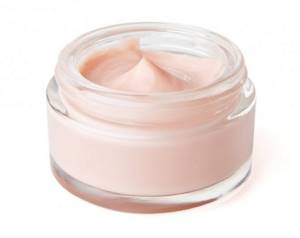
Salmon caviar has found its application in cosmetology: it is used to create creams that prolong the youth of the skin of the body and face. Caviar extract activates metabolic processes in cells, promotes the production of collagen, the removal of free radicals and the regeneration of the epidermis.
In addition, there are many folk recipes for masks that include red caviar. But when using them, do not forget about the three-layer structure of the skin, because the beneficial substances contained in this product must pass through such a barrier for rejuvenation to begin. Therefore, it is better not to experiment, but to trust professional cosmetologists.
The Swiss cosmetics company Laboratoires Valmont has created a series of products to care for aging skin. It contains an extract from salmon milt.
